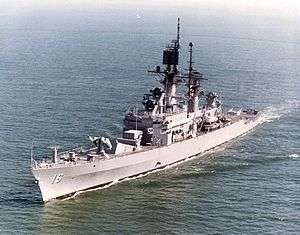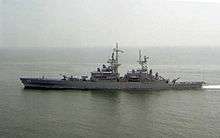Leahy-class cruiser
 USS Leahy (CG-16) | |
| Class overview | |
|---|---|
| Name: | Leahy class |
| Builders: | Several |
| Operators: |
|
| Preceded by: | Albany class |
| Succeeded by: | Belknap class |
| Subclasses: | Bainbridge class |
| Built: | 1959–1964 |
| In commission: | 1962–1995 |
| Completed: | 9 |
| Active: | 0 |
| Retired: | 9 |
| General characteristics | |
| Type: | Guided missile cruiser |
| Displacement: | 7,800 tons (full load) |
| Propulsion: |
|
| Speed: | 32 knots (59 km/h; 37 mph) |
| Range: | 8,000 nautical miles (15,000 km; 9,200 mi) at 20 knots (37 km/h; 23 mph) |
| Sensors and processing systems: | |
| Electronic warfare & decoys: | |
| Armament: |
|
| Aircraft carried: | None |
Leahy-class cruisers were a class of guided missile cruisers built for the United States Navy. They were originally designated as Destroyer Leaders (DLG), but in the 1975 cruiser realignment they were reclassified as guided missile cruisers (CG).
They were a new "double-ender" class fitted with Terrier (later Standard ER) missile launchers fore and aft, and the first and only frigate class designed without a main gun battery for shore bombardment or ship-vs.-ship engagements—the gun armament was reduced in order to carry a larger missile load. One of the principal missions of these ships, like their predecessors the Farragut class, was to form part of the anti-air and antisubmarine screen for carrier task forces, while also controlling aircraft from the carrier by providing vectors to assigned targets.
The ships carried over the propulsion plant of the Farragut class, fitted into a longer hull designed with a knuckled “hurricane” bow that reduced plunging in a rough sea, thus keeping the forecastle dry as needed to operate the forward missile launcher. Other features included an expanded electrical plant and increased endurance. A major design innovation was the use of "macks"—combined masts and stacks—on which the radars could be mounted without smoke interference.[1]
Description
The first three ships were constructed at Bath Iron Works, the next two at New York Shipbulding Corp, and the rest at Puget Sound Bridge and Dry Dock Company, Todd Shipyards, San Pedro, CA, San Francisco Naval Shipyard and Puget Sound Naval Shipyard.
Modernizations were accomplished between 1967 and 1972, upgrading air warfare capabilities. Nearly all modernizations were completed at Bath Iron Works, but Leahy received the modernization at Philadelphia Naval Shipyard at a cost of $36.1 million.[2]
All Leahy-class ships were modernized again in the late 1980s New Threat Upgrade program. This program added advanced air search and track radars (AN/SPS-49 and AN/SPS-48E), updated targeting radars (AN/SPG-55), and combat direction systems. The upgrade included massive remodeling of the ship from food service space rehabilitation to a main propulsion system overhaul.[3] Entire systems were removed and replaced, for example the AN/SPS-40 air-search radar was replaced with the AN/SPS-49 air-search radar. The upgrade was also quite expensive and the ships didn't serve much longer after the modification. For example, USS Gridley (CG-21) received NTU in 1991 at a cost of $55 million, but was decommissioned in early 1994.
The Leahy class (and near sisters of the Belknap class) were taken out of service in the early 1990s as part of the Clinton Administration's desire to reduce defense spending in light of reduced tensions with Russia. The entire class was decommissioned between 1993 and 1995, stricken from the naval register, and transferred to the Maritime Administration (MARAD) for disposal.
USS Bainbridge
1.jpg) USS Bainbridge (CGN-25) | |
| Class overview | |
|---|---|
| Name: | Bainbridge class |
| Builders: | Bethlehem Steel Corporation |
| Operators: |
|
| Built: | 1959–1962 |
| In commission: | 1962–1996 |
| Completed: | 1 |
| Active: | 0 |
| Retired: | 1 |
| General characteristics | |
| Class and type: | Guided missile cruiser |
| Displacement: | 9100 tons |
| Length: | 172.1 m (565 ft) |
| Beam: | 17.6 m (58 ft) |
| Draft: | 3.2 m (10 ft) |
| Propulsion: | 60,000 shp (45,000 kW); 2 G.E. Reactors (D2G), Geared Turbines, 2 screws |
| Speed: | 34 knots (63 km/h; 39 mph) |
| Range: | Unlimited |
| Complement: | 475 |
| Sensors and processing systems: | |
| Armament: | As Leahy class |
USS Bainbridge (CGN-25) was a nuclear-powered development of the Leahy-class. Originally a guided missile destroyer leader, the class was re-designated guided missile cruiser in 1975. As with USS Long Beach (CGN-9) and USS Enterprise (CVN-65), Bainbridge was the only member of its single-ship class.
Bainbridge was largely identical to the Leahy class[6]:329 except for the replacement of the conventional design's four 1,200 lb/in2 steam boilers with two D2G reactors, and related increases in displacement, length and beam.[6]:331 Bainbridge's engineering department carried 7 officers and 156 enlisted men—respectively 3 and 42 more than a contemporary steam-powered vessel.[6]:331
The lessons learned on Bainbridge were later adapted to the next nuclear-powered ship, USS Truxtun (CGN-35) and the California and Virginia classes of nuclear-powered cruiser.
Ships in class
| Name | Pennant | Builder | Laid Down | Launched | Commissioned | Decommissioned | Fate |
|---|---|---|---|---|---|---|---|
| Leahy-class conventional cruiser | |||||||
| Leahy | CG-16 | Bath Iron Works, Bath | 3 December 1959 | 1 July 1961 | 4 August 1962 | 1 October 1993 | Broken up at Brownsville, 2005 |
| Harry E. Yarnell | CG-17 | 31 May 1960 | 9 December 1961 | 2 February 1963 | 29 October 1993 | Broken up at Philadelphia, 2002 | |
| Worden | CG-18 | 9 September 1961 | 2 June 1962 | 3 August 1963 | 1 October 1993 | Sunk as target, 17 June 2000 | |
| Dale | CG-19 | New York Shipbuilding Corporation, Camden | 6 September 1960 | 28 June 1962 | 23 November 1963 | 27 September 1994 | Sunk as target, 6 April 2000 |
| Richmond K. Turner | CG-20 | 9 January 1961 | 6 April 1963 | 13 June 1964 | 13 April 1995 | Sunk as target, 9 August 1998 | |
| Gridley | CG-21 | Lockheed Shipbuilding and Construction Company, Seattle | 15 July 1960 | 31 July 1961 | 25 May 1963 | 21 January 1994 | Broken up at Brownsville, 2005 |
| England | CG-22 | Todd Shipyards, San Pedro | 4 October 1960 | 6 March 1962 | 7 December 1963 | 21 January 1994 | Broken up at Brownsville, 2004 |
| Halsey | CG-23 | San Francisco Naval Shipyard | 26 August 1960 | 15 January 1962 | 20 July 1963 | 28 January 1994 | Broken up at Brownsville, 2003 |
| Reeves | CG-24 | Puget Sound Naval Shipyard, Bremerton | 1 July 1960 | 12 May 1962 | 15 May 1964 | 12 November 1993 | Sunk as target, 1 June 2001 |
| Bainbridge-class nuclear powered cruiser | |||||||
| Bainbridge | CGN-25 | Bethlehem Steel Corporation, Quincy | 5 May 1959 | 15 April 1961 | 6 October 1962 | 13 September 1996 | Disposed of through Ship-Submarine Recycling Program at Bremerton, 1999 |
Gallery
.jpg) Worden prior to modernization in late 1960s or early 1970s.
Worden prior to modernization in late 1960s or early 1970s. Gridley after modernization, but prior to NTU.
Gridley after modernization, but prior to NTU. Bainbridge in 1991
Bainbridge in 1991
See also
References
- ↑ "A Historical Review of Cruiser Characteristics, Roles and Missions". Future Concepts And Surface Ship Design Group (05D),
Naval Sea Systems Command, Department of the Navy. 28 March 2005. Retrieved 29 May 2012. line feed character in
|publisher=at position 53 (help) - ↑ Jane's American fighting ships of the 20th century / compiled and edited by John Moore; preface by M. Staser Holcomb. New York, N.Y. Mallard Press, 1991. ISBN 0-7924-5626-2
- ↑ CG-16 Leahy class
- 1 2 3 4 5 Blackman, Raymond V. B. Jane's Fighting Ships (1970/71) p.430
- ↑ Polmar, Norman "The U.S. Navy: Shipboard Radars" United States Naval Institute Proceedings December 1978 p.144
- 1 2 3 Friedman, Norman (2004) [1982], U.S. Destroyers: An Illustrated Design History, Illustrated Design Histories (revised, illustrated ed.), Annapolis, MD, United States: Naval Institute Press, pp. 327–334, ISBN 9781557504425, OCLC 51861947, retrieved October 13, 2012,
The Bainbridge was essentially a nuclear version of the Leahy class.
External links
| Wikimedia Commons has media related to Leahy class cruiser. |